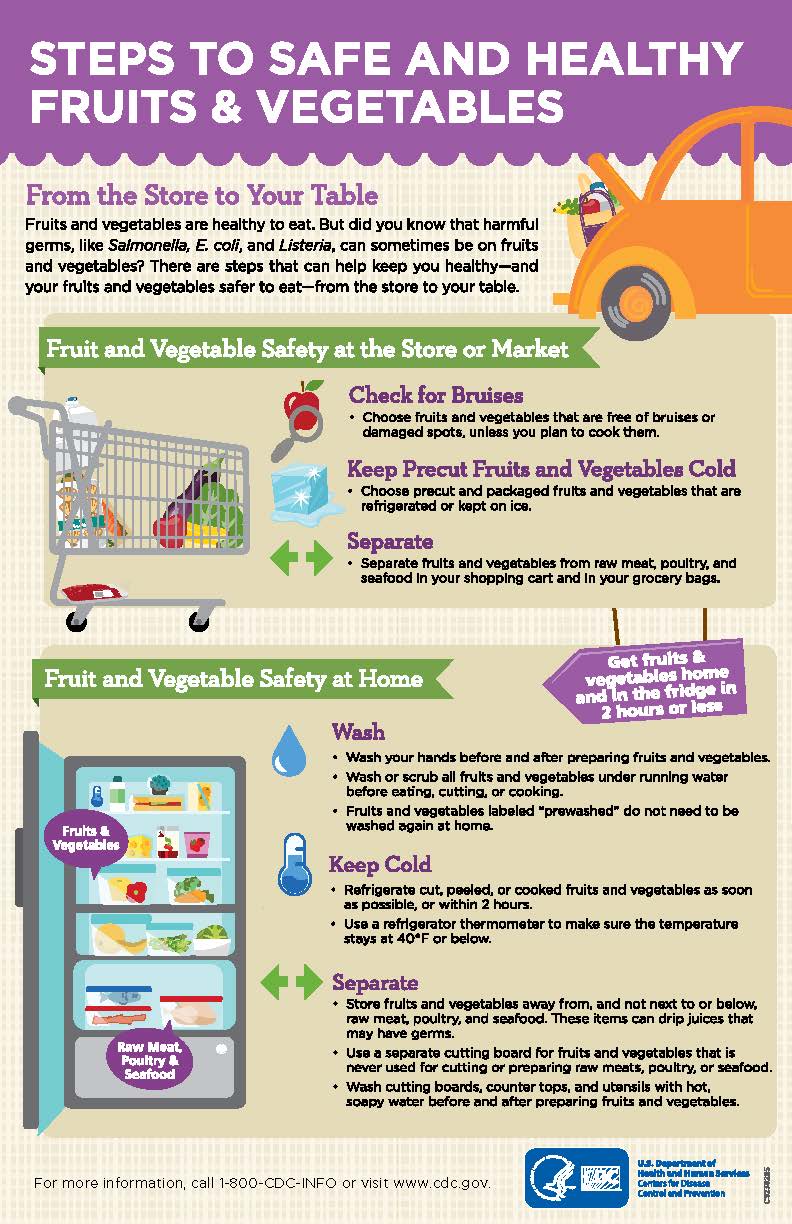Playing It Safe With Produce
By Howard Seltzer, National Education Advisor, Center for Food Safety and Applied Nutrition, Food and Drug Administration
 Fruits and vegetables are an important part of a healthy diet. We can choose from an amazing variety of nutritious and delicious fresh fruits and vegetables. But pathogens that may be in the water or soil where produce grows may come in contact with fruits and vegetables and contaminate them. Fresh produce may also become contaminated after it is harvested, during packing or storage for example. Eating contaminated produce (or fruit and vegetable juices made from contaminated produce) can lead to foodborne illness, often called “food poisoning.” FDA has proposed new rules to help make produce safer but, whether produce comes from a farmers market, a supermarket, a roadside stand, or your own garden, follow these safe handling tips to help protect yourself and your family.
Fruits and vegetables are an important part of a healthy diet. We can choose from an amazing variety of nutritious and delicious fresh fruits and vegetables. But pathogens that may be in the water or soil where produce grows may come in contact with fruits and vegetables and contaminate them. Fresh produce may also become contaminated after it is harvested, during packing or storage for example. Eating contaminated produce (or fruit and vegetable juices made from contaminated produce) can lead to foodborne illness, often called “food poisoning.” FDA has proposed new rules to help make produce safer but, whether produce comes from a farmers market, a supermarket, a roadside stand, or your own garden, follow these safe handling tips to help protect yourself and your family.
Buy Right
Help yourself avoid contaminated produce by making wise buying decisions:
- Purchase produce that is not bruised or damaged.
- When selecting pre-cut produce — such as a half a watermelon or bagged salad greens — choose only those items that are refrigerated or surrounded by ice.
- Bag fresh fruits and vegetables separately from raw meat, poultry and seafood products when packing them to take home from the market.
Store Properly
Proper storage of fresh produce can affect both quality and safety:
- Keep your refrigerator set at 40° F or below. Use a fridge thermometer to check!
- Store perishable fresh fruits and vegetables (like strawberries, lettuce, herbs, and mushrooms) in a clean refrigerator at 40°F or below. If you're not sure whether an item should be refrigerated to maintain quality, ask your grocer.
- Refrigerate all produce that is purchased pre-cut or peeled.
Separate for Safety
Keep fruits and vegetables that will be eaten raw separate from other foods such as raw meat, poultry or seafood — and from kitchen utensils used for those products. Take these steps to avoid cross-contamination:
- Wash cutting boards, dishes, utensils and counter tops with soap and hot water between the preparation of raw meat, poultry and seafood products, and the preparation of produce that will not be cooked.
- If you use plastic or other non-porous cutting boards, run them through the dishwasher after use.
Prepare Safely
When preparing any fresh produce, begin with clean hands. Wash your hands for at least 20 seconds with soap and warm water before and after preparation.
- Cut away any damaged or bruised areas on fresh fruits and vegetables before preparing and/or eating. Produce that looks rotten should be discarded.
- Wash all produce thoroughly under running water before eating, cutting or cooking. This includes produce grown conventionally or organically, grown at home or purchased from a grocery store or farmer's market. Washing fruits and vegetables with soap or detergent or using commercial produce washes is not recommended.
- Even if you plan to cut the rind or peel off the produce before eating, it is still important to wash it first so dirt and bacteria aren’t transferred from the knife onto the fruit or vegetable.
- Scrub firm produce, such as melons and cucumbers, with a clean produce brush.
- Dry produce with a clean cloth towel or paper towel to further reduce bacteria that may be present.
What About Pre-Washed Produce?
Many pre-cut, bagged, or packaged produce items like lettuce are pre-washed and ready-to-eat. If so, it will be stated on the packaging. If the package indicates that the contents are pre-washed and ready-to-eat, you can use the produce without further washing. It is possible that additional handling may contaminate a product that was clean.
If you do choose to wash a product marked “pre-washed” or “ready-to-eat,” be sure to avoid cross contamination that could occur if you handled it with unwashed utensils or dried it on a surface that may not be clean.